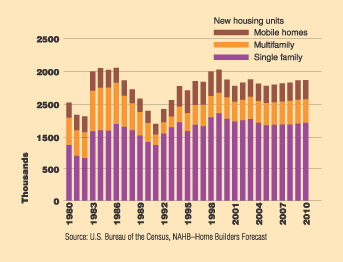Market Snapshot: Building and construction
October 1, 2001
Editor's note: Forward-looking comments reflected in this article were made prior to the terrorist attacks of Sept. 11 and do not take into account how these events will affect the U.S. economy and consumer confidence.
Look around your house and you start to realize just how many injection molded components go into its construction and finish. Behind the walls are pipe fittings and end caps, inside are lighting fixtures, on the roof are ridge vents, and the window in your front door has molded frames holding the glass. Clearly, appliances play a major part in this market as well: With almost every new house comes a dishwasher, stove, washer and dryer, and refrigerator.
The Economy: It Giveth and It Taketh Away
Fortunately, this market has remained relatively stable in an otherwise diving economy. The National Assn. of Home Builders' forecast ("The Next Decade for Housing"), combined with U.S. Census Bureau data, shows declines this year and last, but predicts a small upturn in 2002 (see Figure 1). By the end of 2002, the report says, housing activity should come close to the average estimated for 2000 through 2010.
The building and construction market is not immune to economic conditions, of course. Most analysts will say that home building is cyclical, but it's up for debate whether these cycles can be predicted. In an article from Builder Online titled, "The Road Ahead," Ivy Zelman, home building analyst for Wall Street investment bank Credit Suisse First Boston, points out the impact the economy has on this cycle.
"If we have growth in the GDP of even 1 percent, 2 percent, or 3 percent, and unemployment and [interest] rates stay low, we may see more people spending money on buying homes and less on stocks," the article quotes Zelman. "If fixed-interest mortgage rates stay at about 7 percent or less, housing sales will remain healthy. If consumer confidence tanks because the stock market dives and layoffs accelerate, we'll see a direct impact on home building."
Recent activity in the stock market is also giving indications of the economic impact not just on building, but on builders. Centex Corp., KB Home, and Pulte Homes, the top three homebuilders in the country, pulled down the S&P Home Building index 5.35 percent in September, according to a Sept. 7 Reuters report. Since its all-time high in July of 198.61, the index has fallen 23 percent.
|
Figure 1. Following strong showings in 1998 and 1999, new housing units fell 5 percent in 2000 and this year are expected to dip another 5 percent, according to the National Assn. of Home Builders. The NAHB's forecast for new home production through 2010 is relatively stable, showing only mild, demographically based fluctuation beyond the near-term slowdown-recovery period—a 3 percent rebound in 2002. |
WHAT TO WATCH FOR |
These trends . . . Are driving houses to . . . Source: Builder Online, www.builder.hw.net (Ian Jacobs, Goldman Sachs). |
When the Heat is On
Providing insight on directions for materials in home building, Rick Stepien, commercial director, engineered styrenic resins at GE Plastics (Pittsfield, MA), points to the increasing demand for weatherability. Based on complaints filtering in from consumers to retail giants such as Home Depot and on to OEMs, material suppliers are being asked to provide higher-heat resins with the ability to mold in color on products the customer can then paint. "Retailers wield enormous influence on the suppliers," notes Stepien.
An example of an application requiring these properties is a window profile for a front door. Stepien says that traditionally a high-impact polystyrene or filled polypropylene would be used; however, PS can't withstand the hot conditions in the southern U.S., and filled PP doesn't paint well. "A number of manufacturers have switched to an ASA blend," he says.
Strictly comparing material prices, ASA is more expensive, but it also provides the needed heat resistance, modulus, and molded-in color. In addition, Stepien adds, a homeowner can paint the window frames later without the need for a primer if he or she decides to change the door color. Other components moving to ASA include molded parts that accompany vinyl siding (historically PVC) and fencing caps and accessories.
In lighting, Stepien has seen fluorescent lighting manufacturers searching for a resolution to the brittleness of acrylic. A clear acrylic/ABS blend in the Cycolac family developed by GE contains a rubber impact modifier that Stepien says solves this issue.
How to Win
To find out what molders in this market are saying, IMM spoke with Charlie Headrick, president of Headrick Building Products (HBP) in Cumming, GA. HBP captively molds polypropylene shingle-over ridge vents.
Headrick points to an established trend within the housing market toward products that require little or no upkeep. "Even though the housing market may not be expanding rapidly right now, there's still going to be growth going on because of the continued trend toward more maintenance-free items," he explains. "All that will lead to more polymer materials being used because of the [low-maintenance] nature of those materials."
HBP has been able to achieve success in this saturated market, says Headrick, through innovative product design and competitive pricing resulting from low overhead and high automation. HBP runs just one machine—a 1500-ton Milacron—and automates every part of the ridge manufacture. An Automation Tooling Systems robot moves the molded part to secondary automation from ATS Carolina that affixes nails to the shingle and performs the packaging. "Our product is untouched by human hands," says Headrick.
You May Also Like



